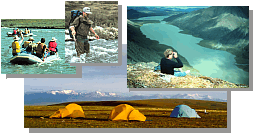 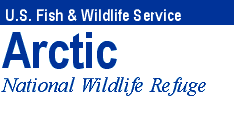
Refuge Information | Wildlife | Habitat | People
Home | New | Feedback | Index | Search
Why we archived the ANWR website at MapCruzin.com
Leaving No Trace:
Keeping Wilderness Wild
Shadows of tall spruce crept toward the circle of kayakers relaxing on a rocky gravel bar of
the remote Sheenjek River. Their tents up, dinner and camp chores done, they savored the
fleeting display of sunlight on the valley's fall aspens as their wandering discussion of ecology
found an earthy focus.
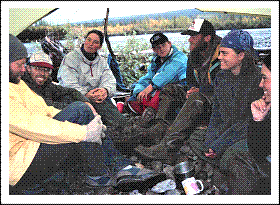 Waiting out the rain, the group takes advantage
of the time to hold one of their discussions on environmental awareness. Waiting out the rain, the group takes advantage
of the time to hold one of their discussions on environmental awareness.
There's a connection," said Paul Jacobson, "between my decision to use a rock in place of
toilet paper here in the wilderness and getting into a more environmentally sustainable lifestyle
back home.
Jacobson, a sandy-haired 33-year-old buyer for a wholesale importing company, quickly
scanned the stones near where he sat. He picked a promising one - narrow, rounded, about the
size of a fat pancake - and displayed it before his fellow campers.
"And really, a rock is no hardship," he said with a smirk, "as long as you pick one that's
anatomically correct - and smooth."
The group laughed and continued talking about their recent experiences with "natural"
substances for toilet paper.
It was the need for awareness of the small, yet cumulative environmental consequences of
individual decisions that was the focus of this journey. Five students and two instructors were
part of a three-week Leave No Trace educational expedition conducted by the National Outdoor
Leadership School, known as NOLS. Based in Lander, Wyoming, the non-profit school teaches
minimum impact camping and travel techniques, expedition leadership and environmental
awareness in wilderness settings throughout the world.
A goal of the rather stringent techniques being taught on this trip was to enable students to
"travel the soft path in wilderness." Striving to avoid impacts, the campers sought to leave no
evidence that they had traveled through the area.
As a representative of the U.S. Fish and Wildlife Service assigned to the Arctic National
Wildlife Refuge, I had managed to meet the group to observe their techniques. The Sheenjek,
like many rivers in the Refuge, has seen dramatic increases in public use in recent years, and a
corresponding increase in complaints about erosion of wilderness qualities. I was interested in
documenting practices that might be recommended to enable visitors to lessen their impacts.
A broader purpose of the curriculum, I was to find, is to foster a personal ethic of care for the
environment; to heighten awareness, as the primer says, of the individual's and society's impacts
on the global ecosystem.
Smith Works, a 17-year-old high school senior, confessed to "shock" when, after the Bush
plane dropped them off 17 days earlier, she learned that no toilet paper had been brought for the
three-week floating and hiking trip. She had often camped with her family, but "this minimum
impact camping wasn't our tradition." But being a good sport - and having no alternative -
she experimented with stones (they're OK), spruce boughs (strictly one way), and cones (too
small) before finally settling on moss (so smooth!).
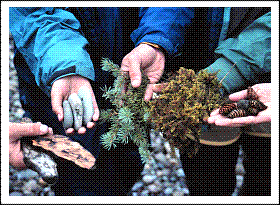 Sticks, spruce boughs, smooth rocks, moss, cones
- the NOLS class tried several alternatives to toilet paper. Sticks, spruce boughs, smooth rocks, moss, cones
- the NOLS class tried several alternatives to toilet paper.
Jacobson, too, had pampered himself with moss the first few days, but quit. "I felt bad about
ripping it out," he said. "So I got into sticks and stones."
"Well, it's wiper's choice," laughed Deborah Sussex, the trip co-leader.
Sussex, who has led dozens of trips ranging from the Noatak River to the coast of Baja,
recalled that the conversation wasn't so jocular that first night when she introduced the human
waste management practices they would follow.
"I remember quiet acceptance when I said everyone would have to go at least 200 feet from
the river," she says, "but when I got to explaining there was no toilet paper and the job wouldn't
be done until the feces was smeared over the ground with a stick - well, there were some pretty
squeamish, unbelieving faces."
It was no joke, they learned. A pile of feces decays slowly in the Far North, Sussex had
explained, especially if buried in the region's relatively sterile soils. Smearing increases the
surface area and causes rapid decomposition. "In a short time," she says, "there'll likely be
nothing left."
It all sounded so bizarre here in the isolation of the Sheenjek River. Such small impacts -
little mounds of "No. 2" or bits of toilet paper hidden here and there - seem so minuscule in the
utter vastness of the Brooks Range.
"Not leaving anything, not even a little square of TP - it's more than maintaining
ecological and aesthetic pureness here," explains Sussex. "It's a starting point fro thinking about
the consequences of our lifestyle, and considering the little things we can all do back home to
make our lifestyle more sustainable."
The group had pulled ashore early that afternoon. After securing the kayaks, Sussex and trip
co-leader Michael Dietzman watched their students scout the broad willow-covered gravel bar
for a suitable campsite.
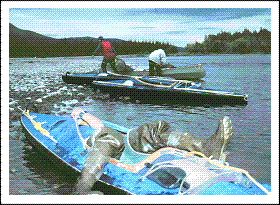 A student retrieves gear stuffed in the front of a
kayak. A student retrieves gear stuffed in the front of a
kayak.
"Campsite selection is probably the singe most important aspect of minimum impact
camping, " said Dietzman, who has also taught wilderness skills courses from Baja to Alaska.
He explained that students were searching for the most durable level surface to pitch their tents.
A good site would have resilient vegetation such as moss rather than, say, dry lichens, which
break easily. But a preferred surface would be sand or gravel, where no plants would be crushed.
They would bypass the most scenic areas, selecting sites that are less likely to be used by other
groups. Another important consideration, he said, is to avoid sites near berry patches or where
bear sign is present.
Having found a sandy area back from the river, two students began to set up tents. The
others looked for a cooking area, starting 100 yards from the tent sites. Cooking is done away
from the tents to minimize traffic on any one area, Dietzman explained, adding that reducing
trampling had been an especially important concern when they camped near tundra farther
upriver.
Separating the cooking and food storage from the tents also helps avoid bear encounters. So
does not bringing odorous foods, such as bacon and fresh meat.
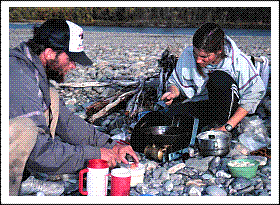 Leaders Mickael Dietzman and Deborah
Sussex begin to set up their kitchen. Cooking sites are located on durable surfaces, such as rock
or sand, to avoid trampling plants. Leaders Mickael Dietzman and Deborah
Sussex begin to set up their kitchen. Cooking sites are located on durable surfaces, such as rock
or sand, to avoid trampling plants.
"We don't carry a bear gun," said Dietzman. "Our precautions are adequate."
"A gun can give a false sense of security," added Sussex. "Without one, campers tend to be
more aware, they're more careful and more humble."
This evening Jacobson, Cathy Hamilton, and Mike Hinckley were partners at the cook site,
an area of flat, good sitting rocks in the shelter of a large spruce root clump that had drifted to
shore. Hamilton, a 20-year-old college student from New York, had never camped before. She
enrolled in this course, she said, because "I had to do something big and difficult."
"The experience is still bit," she said, looking up from the small gas stove she was trying to
light, "but after the first week, the routine is not so difficult.
"The ritual involved in answering nature's call and the inconveniences - like going 200 feet
from the river to wash up - they're something you get used to."
Although the soap brought along for personal hygiene was phosphate-free and
biodegradable, even that is used away from the rivers and lakes to avoid contamination. Pots,
pans, and dishes were washed directly in the river, using sand instead of soap. "It just takes more
scrubbing," Hamilton explained, "but it's a good feeling knowing you haven't put anything
unnatural in the river."
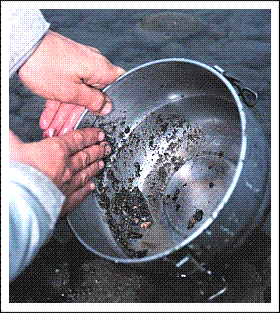 Sand and small rocks are used instead of soap
for washing dishes. It takes a little more scrubbing, according to student Cathy Hamilton, but it
is a good feeling knowing you haven't left anything unnatural in the water. Sand and small rocks are used instead of soap
for washing dishes. It takes a little more scrubbing, according to student Cathy Hamilton, but it
is a good feeling knowing you haven't left anything unnatural in the water.
Jacobson agreed, noting the many polluted rivers he had seen while on business trips in the
Lower 48 and Europe. "There aren't many places like this left in the world," he said, motioning
to the Sheenjek, "where you can just drink right from the river."
In what may be the ultimate in devotion to principle, Jacobson even began to swallow his
toothpaste after brushing, "with a big water chaser." That is not part of the NOLS curriculum
and is, he admitted, well beyond the duty of a conscientious Leave No Trace camper. "But our
society has been so careless in treating its waters - after a while, I thought it would be
interesting to try the other extreme."
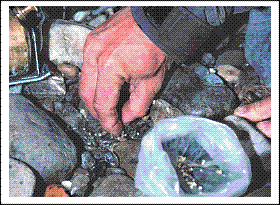 Trip co-leader Mike Dietzman picks up a small
amount of spilled grain. "I know that, ecologically, it doesn't make any difference, "he said,
"but it's the idea of not leaving anything behind." Trip co-leader Mike Dietzman picks up a small
amount of spilled grain. "I know that, ecologically, it doesn't make any difference, "he said,
"but it's the idea of not leaving anything behind."
While Hamilton tinkered with the uncooperative stove, Hinckley unpacked large plastic bags
of macaroni and cheese, and flour, and dried bananas for banana bread that would be their
contribution to the group's potluck dinner. NOLS doesn't use the prepackaged individual freeze-
dried dinners that are de rigueur for most backcountry trips.
"Buying in bulk required more planning," Hinckley explained, "but our meals taste better
and don't result in a lot of needless trash."
Indeed, the group's 17-day accumulation of trash and garbage - packaging, food scraps,
and yes, even coffee grounds - amounted to less than a half duffle bag. "That's everything,
Hinckley said. "We haven't left, burned, or buried anything." Burning, according to NOLS,
often leaves residual food particles and melted plastic and foil. Burying violates the ethic of
leaving nothing behind, and often results in excavation by bears. Especially on long trips like
this, a pack-out-everything policy forces campers to carefully consider what they need.
We've been talking a lot about the waste our lifestyle generates," Hinckley said. "One thing
I'll take back home is the idea that I can get by quite comfortably with less. I was thinking -
maybe I could begin buying a brand of cookies that's not so overpackaged. Maybe I'll buy in
bulk."
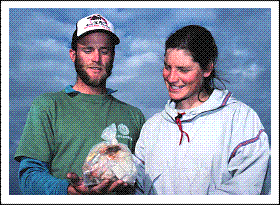 Leaders Mike Dietzman and Deborah Sussex
hold their total accumulation of trash and garbage for a week. Careful planning, buying in bulk,
and avoiding overpackaged products reduce the amount of trash. Leaders Mike Dietzman and Deborah Sussex
hold their total accumulation of trash and garbage for a week. Careful planning, buying in bulk,
and avoiding overpackaged products reduce the amount of trash.
After dinner, nothing was left of the macaroni hot dish and banana bread the three-some had
prepared, nor of the grayling burgers, fried rice, biscuits, and apple fritters contributed by the
others. One thing about those prepackaged freeze-dried dinners: They wouldn't have left such
full stomachs and this lethargic feeling.
As the drifting conversation mellowed, the gathering dusk began to blur the line between
ridgetops and sky, filling the valley with darkness and bringing a sense that ... something was
missing.
Where's the campfire?
"We haven't had one yet," said Dietzman. "But we'll make one before we leave to
demonstrate how to do it in a minimum impact way."
Campfires - at least the way most campers make them - create too much of an impact in
pristine area, he explained. "The impacts each seem small in themselves, but they're
cumulative."
Often, he said, campfires consume too much wood, altering, however slightly, the ecology
and the natural scene. When not properly located they burn through vegetation and sterilize the
soil, making recovery a long-term event. What's worse, he said, is they often leave behind
blackened rocks, charred logs, broken branches - and a diminished sense of wilderness.
"That was me," confessed Micheal Bradt, a 19-year-old college student. "Before this trip, I
couldn't imagine camping without the classic bonfire."
In his former life, Jacobson, too, was "a big fire maker." He was disappointed when he
found out they would use only stoves for cooking. "But now I don't miss it ... it seems an
acceptable trade-off, especially after coming across that old campsite upstream."
The side he referred to was one they found two weeks earlier: a ring of blackened rocks,
some charred sticks, and a few bits of unburned trash in the ashes. Not a major impact by most
standards, but for Jacobson, "It took away some of the area's freshness and our feeling of
exploration."
It was the sort of encounter that for many would be unwelcome, but not entirely unexpected
on public lands. For the next group it might set a standard and that would serve to rationalize
similar practices when conscience conflicts with convenience. But for the NOLS class, it was an
object lesson on what to avoid, and how someone's carelessness can lessen the experience of
those who follow.
"They could have enjoyed a campfire and left almost no trace of it, "Sussex said, explaining
that NOLS is not entirely against the venerable icon of camping.
On occasions when students do build fires, they select a durable site, on sand or gravel, in an
area where wood is abundant - never in high altitude areas where tree growth is slow and
replenishment would take years. They burn sticks gathered from the ground rather than cutting
anything standing. Small wood burns completely, leaving no partially burned logs and only
white ash for disposal in the river next day.
Rain came with the morning light, providing campers with an excuse to linger in their warm
sleeping bags. Their first project was to erect tarps - earth colored, to blend with the
surroundings - over the cooking area. Breakfast was leisurely and coffee time drawn out until
just after noon, when the sky lightened and the group began to break camp.
After the tents were down and all the gear packed to the river, only the most subtle evidence
of their occupation remained. Even that was too much. The campers set out to
naturalize the site.
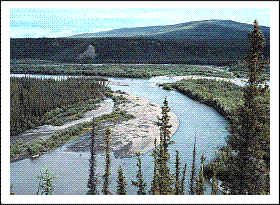 NOLS students set up camp on a rocky gravel
bar of the Sheenjek River. NOLS students set up camp on a rocky gravel
bar of the Sheenjek River.
Jacobson and Hinckley each picked up an end of a driftwood log that had been borrowed for
use as a bench seat. They returned it to its depression in the sand, making a few adjustments so it
would lie exactly as they had found it. Hamilton and Works scattered the rocks that had been
gathered to anchor the tents and tarps, then filled in the tent stake holes. If the tents had been
pitched on a grassy area, Works said, the mapped vegetation would be fluffed up with a stick to
help it recover faster.
Dietzman stood on a drift log between where the tents and cooking area had been,
supervising the restoration effort.
"They know these aren't hard and fast rules," he said, referring to the students' practice of
Leave No Trace techniques. "Some places they'll need to be modified, some places they may
not apply.
"The important thing is the ethic they acquire. They're more aware of the consequences of
their actions now. They'll be better prepared to make Earth-wise choices."
Before casting off, one task remained. Hinckley and Bradt searched the drift piles, each
returning with a weathered spruce bough in hand. Still remaining were ... footprints.
"At first, I thought this was going too far," Bradt said, his voice betraying concern that he
might appear silly for sweeping the sand.
"But it's become a game to remove all traces of our use ... it's going to add a new challenge
to my trips."

Refuge Information | Wildlife | Habitat | People
Home | New | Feedback | Index | Search
Text and graphics by USFWS staff
Last modified 28 July 2000
Why we archived the ANWR website at Mapcruzin.com
Note: This is the MapCruzin.com archive of the FWS Arctic National Wildlife Refuge website. In December, 2001 FWS took this website offline, making it unavailable to the public. It includes 90 plus pages of information and many maps. As of 2006 the important information contained in this, the original "unsanitized" version of the FWS website, has yet to return to the internet, so we will continue to maintain it here as a permanent archive to help inform activists and concerned citizens. If you find any broken links, please report them to me at [email protected] and I will attempt to make the repairs. January, 2008 update - A small part of the original information that was present in 2001 has made it back into the current ANWR website. There is also an archive that contains a small amount of the original information, but it is not readily available from the main website.
Click here to visit our homepage. Click here for NRDC's message about ANWR from Robert Redford.
For more information on why this website was "pulled," Check here. And, you can also view the maps of caribou calving areas that the FWS did not want you to see here.
 January 29, 2008: Visit Our New ANWR News for Updates January 29, 2008: Visit Our New ANWR News for Updates
This page should be cited as follows:
U.S. Fish and Wildlife Service. 2001. Potential impacts of proposed oil and gas
development on the Arctic Refuge�s
coastal plain: Historical overview and
issues of concern. Web page of the Arctic National
Wildlife Refuge,
Fairbanks, Alaska.
17 January 2001. http://arctic.fws.gov/issues1.html
Archived by MapCruzin.com. Visit us at mapcruzin.com.
MapCruzin.com is an independent firm
specializing in the publication of
educational and research resources.
We created the first U.S. based
interactive toxic chemical facility
maps on the internet in 1996 and we
have been online ever since. Learn more about us and view some of our projects and services.
Contact Us
Report Broken Links
| 




